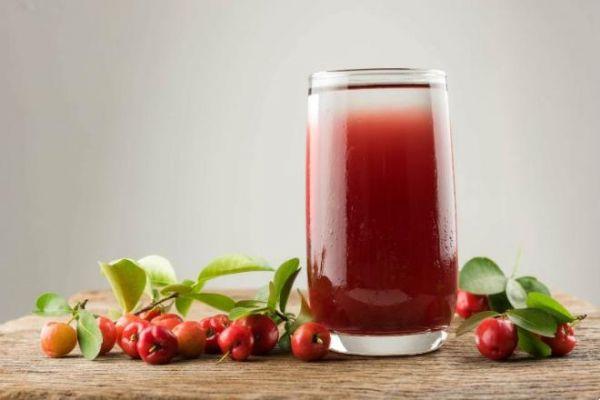
La peculiarities of the acerola fruit is the very high percentage of vitamin C: it is the second among all the fruits existing and known up to now and for this reason it is used as natural vitamin C supplement
From its fruit, a juice rich in ascorbic acid is prepared which is then usually concentrated and used as a natural vitamin C.
An advantage of the vitamin C contained in acerola is its own bioavailability, so much so that it can be absorbed and used by our body completely and quickly without any loss. In reverse, other fruits rich in vitamin C like citrus fruits, kiwis or strawberries, they are easily absorbed but the bioavailability of vitamin C is lower than acerola.
Il acerola juice also contains Vitamin A and many B vitamins and mineral salts such as iron, calcium, phosphorus, potassium and magnesium.
Furthermore theacerola contains substances in its phytocomplex and active ingredients such as i bioflavonoids which include many antioxidants.
Acerola juice for the immune system
Acerola juice thus becomes a excellent supplement that helps in seasonal ailments such as colds, coughs and flu.
Drinking acerola juice as a prevention for winter-related ailments can strengthen the immune system. The presence of various vitamins and in particular vitamin A, vitamin C and those of group B are used for stimulate the organism and becomes a excellent remedy in cases of convalescence and asthenia in general.
Acerola and vitamin C against the flu
Acerola juice for the skin
The presence of vitamin C and Vitamin A in the juice of acerola allows to heal and make the skin beautiful and full of health.
In fact, vitamin C promotes the production of collagen which serves to maintain the structure and tone of the epithelial tissue with a anti-aging effect very effective.
Furthermore, precisely because of his antioxidant capacity, is by its nature a highly effective substance against cellular aging because it fights and reduces free radicals.
In turn Vitamin A serves for the regulation and regeneration of the tissue, prevents and maintains the structural and functional integrity of the skin and mucous membranes and finally reduces sebum.
How to drink acerola juice
They are usually very effective isfreshly extracted juices, drunk as a remedy in the most chronic ailments in quantities of 500 ml of juice per day, away from meals in order not to have interactions with other foods and to let all the phytocomplex of acerola act naturally in the body.
Fresh juice is not yet available in the country but we could find acerola extracts equally good and effective, sold ready-made or to be prepared extemporaneously at home.
These drinking products are recommended in the most common situations or when you want to make one prevention of winter illnesses and in this case it will be a smaller dose of 250 ml acerola juice is sufficient.
There are also other products based on acerola mixed with other fruits rich in vitamin C or drinks that contain a solubilized acerola extract.
The percentage of acerola is shown on the product label itself and the quantities of product intake are usually also recommended. Indicatively they are 5 mg of acerola per kilogram of body weight to take twice a day between meals.
Where to find acerola juice
Fresh acerola juice is sold in the plant's countries of origin and is commonly consumed as natural juice. This fresh juice comes squeezed directly on the spot and drunk instantly thus obtaining 100% of the properties and benefits.
In el country you can find the acerola juice, but not fresh; in fact it is extracted from the fruit and subsequently pasteurized and bottled in tropical countries. It then arrives by importation on the shelves of specialized stores of natural supplements and phytonutrients from all over the world.
In the town we often find acerola dried and pulverized to be able to solubilize in water; the properties remain essentially unchanged even if the fresh juice remains more complete in its phytocomplex than the extracted and processed products.
In stores of natural supplements such as herbalists or organic farming, you begin to find different products based on acerola both as single-dose of acerola only and in complexes with other herbs for healthy use or for the well-being of the person.
Let's remember read the product label and evaluate the presence of vitamin C: indeed an acerola extract contains a maximum of 17% and if you find a higher percentage of vitamin C it could be synthetic and not extracted from acerola but added later. The naturally extractable vitamin C from fruits is more bioavailable and more suitable for the functionality of our body.
Acerola, pawpaw, pepino dulce among the unknown fruits


























